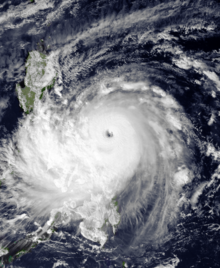 Nina approaching the Philippines at peak intensity on November 25 | |
| Meteorological history | |
|---|---|
| Formed | November 19, 1987 |
| Dissipated | November 30, 1987 |
| Very strong typhoon | |
| 10-minute sustained (JMA) | |
| Highest winds | 165 km/h (105 mph) |
| Lowest pressure | 930 hPa (mbar); 27.46 inHg |
| Category 5-equivalent super typhoon | |
| 1-minute sustained (SSHWS/JTWC) | |
| Highest winds | 270 km/h (165 mph) |
| Overall effects | |
| Fatalities | 1,036 total |
| Damage | ≥$84.5 million (1987 USD) |
| Areas affected | Chuuk Lagoon, Philippines, China, Hong Kong, Macau |
| IBTrACS | |
Part of the 1987 Pacific typhoon season | |
Typhoon Nina, known in the Philippines as Typhoon Sisang, was the most intense typhoon to strike the Philippines since Typhoon Irma in 1981. Typhoon Nina originated from an area of convection near the Marshall Islands in mid-November 1987. It gradually became better organized, and on November 19, was first classified as a tropical cyclone. Moving west-northwest, Nina attained tropical storm intensity that evening. Late on November 20, Nina passed through the Chuuk Lagoon in the Federated States of Micronesia. After a brief pause in intensification, Nina intensified into a typhoon on November 22. Two days later, the typhoon intensified suddenly, before attaining its peak 10 minute intensity of 165 km/h (105 mph; 90 kn). During the afternoon of November 25, Nina moved ashore in Southern Luzon at the same intensity. It gradually weakened over land, before entering the South China Sea and turning to the north. By November 30, Nina dissipated.
Across the Chuuk Lagoon, four people were killed and damage ranged from $30–$40 million (1987 USD). In the capital of Weno, 85% of dwellings and 50% of government buildings were damaged. Throughout the atoll, at least 1,000 people were rendered homeless, approximately 1,000 houses were damaged, and 39 injuries were reported. While crossing the Philippines, Nina brought extensive damage to the northern portion of the island group. The town of Matnog sustained the worst damage from the typhoon, where 287 people died. Sixty-one people died in the city of Sorsogon, where 98% of all structures were either damaged or destroyed. Four hundred people died, 80% of all crops were destroyed, and 90% of all homes were either damaged or destroyed in the Sorsogon province. Nearby, in the Albay province, 73 people were killed. Throughout both the Albay and Sorsogon provinces, four-fifths of all schools and half of all public infrastructure were destroyed. Elsewhere, in Boac, 80% of homes lost their roofs. In Bacacay, 18 of the village's 200 homes were destroyed. However, the capital city of Manila avoided the brunt of the typhoon. Throughout the Philippines, approximately 114,000 people sought shelter, approximately 90,000 houses were destroyed, leaving more than 150,000 homeless. Nationwide, damage from the storm totaled $54.5 million and 979 people perished.